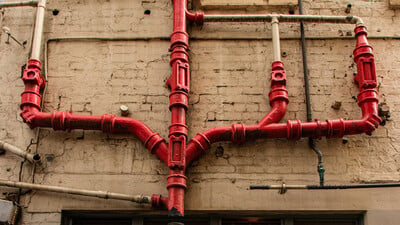Most homeowners rarely give a second thought to the pipework hidden inside their walls and under their floors. These systems quietly carry clean water in and channel waste out – essential for the smooth operation of any household. But when something goes wrong, understanding the difference between soil and waste pipes becomes more than just helpful – it’s essential.
While it’s easy to distinguish between water supply and wastewater systems, the line between soil and waste pipes can be less clear. Yet each plays a distinct role, governed by what it carries, how it's vented, and how it's installed.
Soil vs. Waste Pipes: What's the Difference?
Although both types of pipes transport used water away from your home, their functions and design are very different.
Soil pipes
These deal with foul waste – also known as blackwater – from toilets, urinals and bidets. This type of waste system requires a robust pipe system that’s properly vented and of a wider diameter to safely handle the solids that flow through it.
Waste pipes, by contrast, carry greywater – wastewater from sinks, baths, showers, washing machines and dishwashers. This water may be dirty but doesn’t contain solids or harmful gases. Therefore, the pipes used are smaller and don’t usually require venting.
Why does this matter? Because sewage generates methane and other gases, which must be released. This is why soil pipes are vented, often through a stack that runs above roof level. Waste pipes don’t produce these gases and are typically part of a simpler system.
The Importance of Proper Ventilation
Inadequate ventilation can cause siphoning, where water is sucked from traps under sinks or baths, leading to foul smells and ineffective drainage. Soil stacks address this by allowing air to enter the system, either through a roof-level vent pipe or an internal air admittance valve. For more on how this works, see Drainage and waste disposal: Approved Document H in the Useful Links at the end of this article.
How Your Property’s Age Affects Pipework
Older properties often feature separate pipe systems for greywater and blackwater, combining only when they reach the main drain. Modern homes, by contrast, tend to use a single internal stack that carries both types of wastewater vertically down through the building.
If your home has undergone renovations, it may have a hybrid system with external soil stacks and modern internal connections. When in doubt, it’s wise to consult a professional before carrying out plumbing work, especially if the existing system includes older materials like cast iron, which may even contain asbestos.
The Soil Pipe System in Detail
Soil systems are designed to carry human waste to the sewer. Modern installations typically use 110mm plastic (PVC-U) pipes above ground, while 160mm pipes may be used for shared or underground connections. Key components include:
- Soil stacks, either internal or external, that vent through the roof or terminate with an air admittance valve
- Access points for inspection and maintenance
- Branches and boss pipes to connect toilets and waste appliances to the main stack
- Weathering slates and collars for watertight roof penetrations
- Vent terminals to keep out debris and wildlife
Materials have evolved from cast iron to plastic, which is lighter, more flexible, and resistant to corrosion. Where older systems still exist, particularly those containing hazardous materials, professional assessment is vital.
Waste Pipes
Waste systems transport used water from everyday appliances. Since they aren’t dealing with solids or harmful gases, the pipe diameter can be much smaller – usually 32mm for basins, 40mm for showers and sinks and 50mm for more demanding outlets or commercial use.
Plastic has become the preferred material for these systems thanks to its affordability, ease of installation and quiet operation. Copper is still used in high-end or retrofit situations but is more expensive and less common in domestic plumbing today.
Most waste pipe systems connect either to a soil stack or run directly to the main drain. Depending on the system type, you may choose between push-fit and solvent weld fittings. It's important not to mix these connection types unless using the proper adapters.
Pressure Regulation: Vent Pipes and Air Admittance Valves
As water flows through drainage pipes, it changes the internal air pressure. Without adequate ventilation, this can lead to noise, unpleasant odours, or even backflow into your appliances. This is where vent pipes and air admittance valves come in.
- Vent pipes extend above the roofline to let air in and gases out. These are a standard feature of soil systems and must comply with Building Regulations, rising at least 900mm above any nearby opening.
- Air admittance valves (AAVs) are one-way valves that admit air into the system to equalise pressure but prevent gases from escaping. They are commonly used where an external vent is impractical.
Solving Pressure Imbalances with Air Admittance Valves
In modern drainage design, air admittance valves – sometimes referred to by the brand name Durgo Valves—offer a convenient and efficient solution to the pressure problems that can arise in enclosed waste systems.
These clever one-way valves are designed to admit air into a pipe system when negative pressure (caused by siphoning during drainage) builds up. Crucially, they do this without allowing foul gases or odours to escape. This makes them a practical alternative to traditional vent pipes, especially in properties where external venting above the roofline is impractical.
How AAVs Work
An AAV remains sealed under normal pressure. But when a vacuum is created inside the pipework – for example, when a toilet flushes or a bath drains – the valve opens momentarily to allow fresh air in, balancing the pressure and helping wastewater flow smoothly. Once the pressure stabilises, the valve closes again, keeping odours contained.
AAVs must be installed:
- vertically (upright position only)
- at least 200mm above the highest wastewater entry point in the system
- with adequate space around them for proper airflow
Because they prevent odours from venting into living spaces, AAVs are typically fitted inside the home – in lofts, utility cupboards or service voids – rather than externally. This offers practical benefits such as reduced heat loss (compared to open vent pipes) and less risk of condensation forming on internal surfaces.
But be aware: they’re not always a complete solution.
While AAVs are great at regulating pressure, they don’t expel gases from the system. Instead, any methane and hydrogen sulphide must travel down the pipes into the main sewer. This is only safe if there’s another property or location within the system with a traditional vent stack to release these gases.
As a general rule, at least one in every five connected properties in a drainage run must have an open vent pipe to comply with building regulations. If you’re considering removing a vent stack and replacing it with an AAV, make sure your property isn’t the designated vented one on your run.
For full regulatory guidance, refer to Approved Document H (see Useful Links)
Installing a Soil & Waste System: What to Consider
Installing a soil and waste system involves careful planning, correct fall gradients, and compliance with building regulations. The complexity of the task depends on the type of system you're working with—external or internal, new build or refurbishment, and whether you're connecting to the mains sewer or an off-mains drainage system.
External Soil Stack Installation
For properties with an external soil stack, installation is more accessible and suitable for experienced DIYers.
Key steps include:
Planning the layout
- Identify all connection points for toilets, baths, sinks, and appliances.
- Ensure all horizontal branch pipes fall towards the soil stack at a gradient of 1:40 (25mm per metre) for optimal flow.
Fixing the stack
- Position the vertical soil pipe against the external wall, securing it with pipe brackets at recommended intervals (at least every 2 metres vertically, and at every joint or bend).
- The stack should terminate at least 900mm above any opening window or air vent within 3 metres horizontally, as per Building Regulations Part H.
Connecting branches
- Use appropriate branch fittings at the correct angles (usually 92.5° or swept 87.5°) to join horizontal waste pipes into the stack.
- Each fixture (toilet, basin, bath, etc.) must have a trap to prevent foul air escape and may require additional venting if too far from the stack.
Testing and sealing
- Before final sealing, perform a water test to check for leaks.
- Use solvent weld or push-fit fittings as appropriate for your pipe system.
Internal Soil Stack Installation
If your property features an internal stack, installation becomes more complex due to access restrictions and the need to comply with stricter regulations for air-tightness and fireproofing.
Considerations include:
Accessing the stack
This usually involves removing plasterboard or boxing-in around the pipe, and reinstating these afterwards.
Fire collars and sleeves
Where pipes pass through fire-rated floors or walls, intumescent fire collars must be fitted to restore the fire rating of the structure.
Condensate and airflow
Ensure the installation allows for air movement, or consider fitting an Air Admittance Valve to prevent trap seal loss.
Noise control
Internal stacks should be properly clipped and, ideally, wrapped in acoustic insulation to prevent waste noise from travelling between floors.
Unless you're confident in your abilities, we recommend hiring a plumber or contractor to carry out the replacement of, or significant repairs to, an internal stack.
General Installation Tips
- Use quality materials: Choose durable, high-quality PVC-U pipes and fittings.
- Avoid mixing different plastic types (e.g. ABS and PVC) unless the fittings are compatible.
- Support all pipework properly: Prevent sagging and stress on joints by supporting horizontal runs at least every 1 metre.
- Use access fittings: Include rodding or access points at key locations, particularly near bends and long horizontal runs.
- Keep bends to a minimum: Use swept bends rather than tight angles to maintain flow and reduce blockage risk.
- If connecting to the mains sewer, you must notify your local Building Control body (see Useful Links) before beginning work, and all installations must comply with the guidance set out in Approved Document H.
Maintaining Your Soil & Waste System
Prevention is better than cure when it comes to drainage. Regular maintenance can significantly reduce the risk of blockages, leaks, or costly repairs. Here’s how to keep your system flowing freely.
How to Prevent Blocked Toilets
Toilet blockages are most commonly caused by:
- excessive toilet paper
- improper flushing of wipes or sanitary items
- foreign objects accidentally dropped into the bowl
Be mindful of paper usage, avoid overly thick or quilted brands and never flush wipes—even if labelled “flushable” – as these often snag on pipe bends and can create serious blockages. While “flushable” wipes do indeed decomp[ose I water, the time required for decomposition is long enough for wipes to cause a blockage long before the process is complete.
How to Prevent Blocked Sinks
Kitchen and bathroom sinks are connected to smaller-diameter waste pipes, which are much more susceptible to clogging.
Avoid putting any solids like food scraps, coffee grounds, or thick cream down the plughole. Even oils and fats, which seem harmless in liquid form, can solidify and cause major obstructions around bends.
Remember: if it’s not wastewater, it shouldn’t go down the sink.
How to Prevent Blocked Showers and Baths
Hair is the most common cause of blockages in baths and showers. It binds with soap residue to form stubborn blockages inside waste pipes.
Use a simple hair trap over the drain and get into the habit of removing any visible build-up after each use. This small routine can prevent larger maintenance headaches.
Special Considerations for Off-Mains Drainage Systems
If your property isn’t connected to the public sewer system and instead relies on a sewage treatment plant, septic tank, or cesspool, your maintenance responsibilities become even more critical.
Common off-mains drainage risks include:
- killing beneficial bacteria inside treatment systems (from antibacterial cleaners)
- damaging tanks (with oils, greases or non-biodegradable items)
- overflow or contamination of soakaways and drainage fields
What Not to Flush or Pour into Off-Mains Drainage Systems
Avoid putting the following down toilets, sinks or appliances connected to an off-mains system:
- Bleach or strong disinfectants
- Fats, oils, and grease
- Wet wipes, nappies or sanitary products
- Paints, solvents or engine oils
- Non-biological or phosphate-heavy detergents
Bonus Tip: Save Mains Water with Rainwater Harvesting
Most UK toilets still refill with clean mains water. If you're flushing more than once to manage paper use, consider a rainwater harvesting system to offset water waste. We have a range of blog articles and products related to rainwater harvesting; check out the link in Useful Links.
Plan, Protect, and Maintain
With a solid understanding of how soil and waste systems work – and how to manage them – you’re in a great position to keep your property’s plumbing in top condition. Whether you’re choosing between vent pipes and AAVs or wondering how to prevent blockages, proactive planning goes a long way.
When you’re ready to upgrade or repair your system, we stock a full range of high-quality PVC soil and waste pipes and fittings to suit almost any project. In the meantime, enjoy reading our other helpful information on the subject to expand your knowledge and when you’re ready, contact Drainfast for friendly, professional advice and quality drainage products, delivered nationwide from our well-stocked depots.
Useful Links:
- Drainage and waste disposal: Approved Document H: https://www.gov.uk/government/publications/drainage-and-waste-disposal-approved-document-h
- Find Your Local Building Control Authority:
- Rainwater Harvesting Blog Articles and Products: https://www.drainfast.co.uk/search?text=rainwater+harvesting

Written by
Bob Stone
Technical Sales
Heading up our Technical Estimating Department, Bob is our in-house quantity surveyor.

